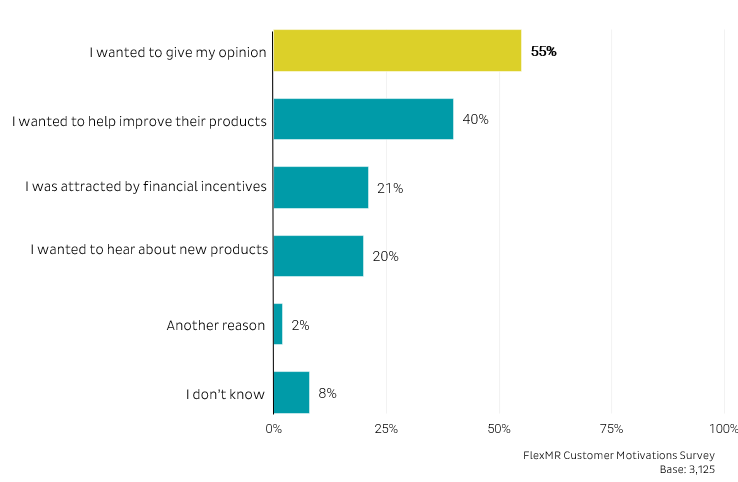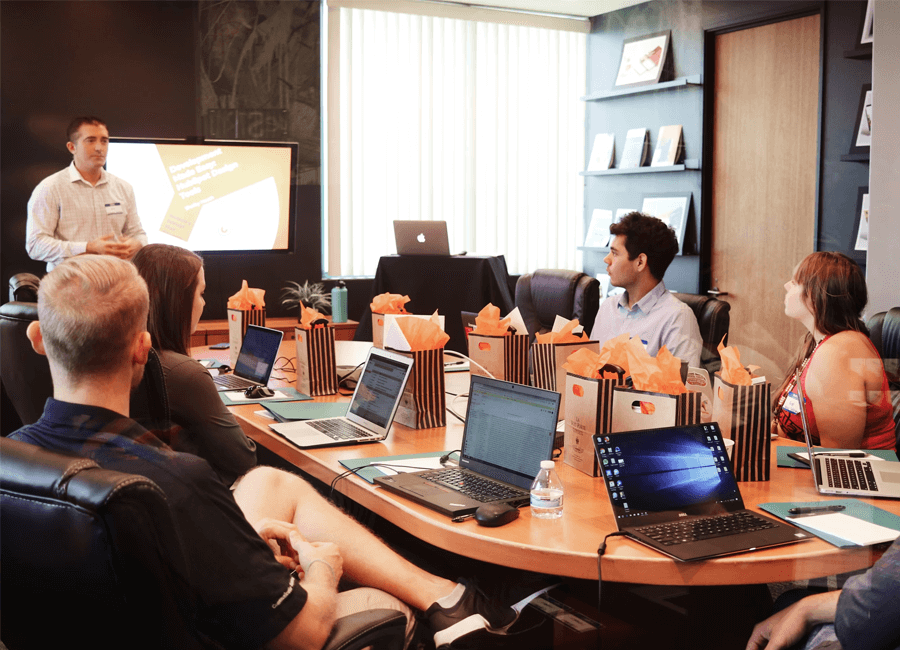Members of insight communities are motivated to participate in market research in many ways as we can see from the graph below; some are persuaded by financial incentives (21%), while others by wanting to make a difference by improving products or services (40%), and some people just want to feel like they’re being listened to and give their opinion (55%).

Due to this, both stakeholders and insight experts need to employ various tactics to motivate each type of participant, as they’ll not all be motivated in the same way. It’s also important to provide value to your members, as without they will lose interest. You’ll gain value from the insights and feedback from your members, but what are you giving them in return?
So, how can we keep members motivated & engaged? We tested four distinctly different motivations to see if they reflected any of the participant’s desires, and the results have helped us understand exactly why participants engage in market research. Let’s take a look at four popular engagement tactics that we can use to help bring the motivations in the graph above to life:
- Engagement content
- Provide regular feedback
- Financial incentives
- Check-in with your members
| Tweet This | |
| 55% of research respondents participate specifically because they want to share their opinion - using this with other motivation tactics can keep members engaged in research for longer. |
1. Content for Engagement
Your community should have fresh content/activities for members on a regular basis. You don’t want people logging on to find old activities from weeks or even months ago. So, while you may not have scheduled research activities running consistently all year round, it’s still important to keep your community engaged. So, when a research project does come in you have a set of people who are ready to take part providing you with quick insights.
Engagement content is great for providing members with quick, lighter activities to keep them interested in the community. It’s typically not used for heavy research questions, but engagement content can complement any upcoming or ongoing research. Any answers members give may also spark an interesting unknown that could lead to further questions.
I’d recommend making a content calendar so you can plan out a few engagement activities per month alongside/around any research as well as around the interesting unknowns that crop up. These can be forums, quick polls or other easy-to-participate-in activities. Just remember, engagement activities are to complement the research, not to be the research.
2. Provide Regular Feedback
Giving feedback is important for a community to thrive. Without feedback, members may become disengaged and wonder if they are making any impact or even being listened to at all. As you can see from the graph at the start of the blog, 40% of people were motivated by wanting to improve services/products. So, do put some time aside regularly to give your members feedback and let them know how they are improving and changing things through the data they provide.
Short fortnightly newsletters are great for updating members on what’s happening in the community, and inviting members to any new activities. By having regular contact, members will know when to expect communications and it will prompt them to log in and check out your new activities. If you run lots of research in your community you could provide some quick statistical feedback, but the key is to keep it short in the fortnightly updates.
Your quarterly newsletter is great for going into some depth about what research has been going on and how their participation has helped the stakeholder organisation. By choosing to do this quarterly the receiver won’t feel overwhelmed, as this newsletter should be lengthier and more in-depth. The type of things you should be feeding back to your members is how the research is helping inform strategies, product development, the customer experience, and more specifically what decisions it’s influencing in the boardroom. If you are unable to share some of this information, you could look at sharing a few direct quotes from stakeholders about how much they value the time and details members are putting into the research activities. This shows your community they are helping even if you are unable to say what it’s directly influenced.
You can also set up a ‘You said, we did’ page on your community. This can be a great point of reference for new members when they join, as they can see straight away see that changes do happen based directly on member feedback. It’s also great to remind other members of all the things they’ve improved/changed by taking part in your activities.
Finally, a yearly round-up page or newsletter can demonstrate to your community the scale, reach and influence of feedback collected. You can include statistics such as the number of members in the community, the number of polls voted on, the amount research projects that ran in the year, plus the number of financial incentives paid out. As well, as an overview of the research projects completed within that year and the decisions made off the back of those projects.
3. Financial Incentives
Financial incentives will motivate and encourage many members to get involved in your community. There are many strategies you can implement to encourage members to participate. These include monthly prize draws, ad-hoc incentives and research incentives.
Firstly, it’s beneficial to offer monthly prize draws. This ensures members have an overall financial incentive to take part. The draw could be set so any active members who’ve logged in during the month are then entered into the prize draw, and then they can have additional entries every time they complete activities. This ensures those who may have joined but never taken part in anything don’t win, as that would be demotivating to the members who do take part. The prize draw encourages members to log in at least once a month, as some will log in to check if they’ve won, then also check out your latest content.
Ad-hoc rewards are also great to add an element of surprise to the community and typically spur a boost of new activity. You could give the best community contributor of the month a cash reward. This will make that member feel more appreciated and the action will encourage others to perhaps engage more and provide lengthier responses. You could also offer a reward to the most helpful open-ended response on a survey, or reward a member for starting a great forum discussion.
| Tweet This | |
| As much as the insights industry depends on financial incentives, only 21% of our respondents mentioned financial incentives as motivation to participate in market research. |
If possible, it’s great to add a personal touch to members receiving a prize/incentive. For example, you could send out a gift voucher inside a handwritten thank you card. This personal touch shows the member they are interacting with humans as well as just being a nice thing to do to show appreciation. This is particularly important nowadays with the rise of artificial intelligence. Anything you can do to add human touches to your community will be seen as more meaningful. The possibilities are endless, it’s about having fun with the community and rewarding those who are contributing.
Finally, it’s important to understand that some members will not take part in all activities. Some are only interested in the paid research opportunities. The financial incentive you offer members should be dependent on how long the activity will take the participant. For example, if you’re asking someone to give up 30mins – 1 hour of their time in an online focus group the financial incentive will be much greater than a short survey or quick poll question. Another thing you need to consider when deciding how much to pay out is the type of participant you’re needing to recruit. If you need decision-makers within a business you will need to give them a larger incentive as they are harder to reach people and taking part in your research needs to be worth their time.
4. Check-in with Members
If you’re struggling to see any improvement with your engagement it will be useful to check in with your members and see why they are disengaged. Most people are very happy to give their opinion (as you can see from the graph above). Perhaps there is a difference between what members expected the community to be like and what the reality is, perhaps they enjoy taking part in surveys but the community mainly focuses on forums or quick polls. Information is key to re-engaging your members. Once you’ve got feedback, look and see what you can change then feedback to your community. When members see they are being listened to it may improve their perspective of the community and by targeting them with activities they enjoy, they are more likely to engage with them.


















